Research on the Improvement Effect and Mechanism of Micro-Scale Structures Treated by Laser Micro-Engraving on 7075 Al Alloy Tribological Properties
Abstract
:1. Introduction
2. Materials and Methods
2.1. Materials
2.2. Surface Treatments
2.3. Characterization
3. Results and Discussion
3.1. Characteristics of As-Prepared Micro-Scale Structure Surfaces
3.2. Tribological Properties of the Linear Groove Surface (LGS)
3.3. Tribological Properties of the Gridding Groove Surface (GGS)
3.4. Tribological Properties of the Arc Groove Surface (AGS)
3.5. Improvement Mechanism and Influence Degree of the Micro-Scale Structures
4. Conclusions
- The as-prepared micro-scale structure surfaces can greatly improve the tribological properties of 7075 Al alloy. The tribological properties improvement mechanism of Al alloy micro-scale structure surfaces can be summarized by four factors: (1) The improvement of surface hardness decreases deformation of the surface layer materials at a constant load, and improves resistance to abrasive wear, (2) the concave structure of the surface reduces the real contact area between the friction pair and the surface, (3) the concave structure can capture wear debris and reduce abrasive wear, and (4) the concave structure, which has an orientation parallel to the sliding direction, can weaken the ploughing effect induced by the steel ball.
- The concave structure of the gridding groove surface and arc groove surface can only capture wear debris. However, the concave structure of the linear groove surface can not only capture wear debris, but also move wear debris away from the friction zone, which further improves the performance of the capturing wear debris effect and decreases the abrasive wear of Al alloy.
- Due to the significant influence of the concave structure distribution density of the micro-scale structure surface on reduction of the real contact area and performance of capturing wear debris, the effect of the micro-scale structure surface on improvement of the tribological properties of the Al alloy is weakened greatly by increasing texture spacing, under different conditions.
- Under a low sliding speed, if the sliding speed is parallel to the orientation of the concave structure, the reduction of the ploughing effect plays a major role in the improvement of the tribological properties. Otherwise, the improvement of surface hardness (if the concave structure distribution density is less than 40%) and the decrease of the real contact area induced by the concave structure (if the concave structure distribution density is more than 40%) play a major role in the improvement of the tribological properties.
- Under a high sliding speed, as the effect of capturing wear debris on the tribological properties gradually increases, the effect of the micro-scale structure on the improvement of the tribological properties is mainly due to the ability induced by the concave structure of the micro-scale structure surface of capturing wear debris.
- Compared with a concave structure of the micro-scale structure surface that can only capture wear debris, the capturing wear debris performance of a concave structure that can capture and remove wear debris is affected greatly by the sliding speed.
- Under a low sliding speed, the arc groove pattern with a texture spacing of 150 μm is the optimal choice to efficiently improve the tribological properties of 7075 Al alloy. By contrast, under a high sliding speed, the linear groove pattern with a texture spacing of 150 μm enhances the tribological properties of Al alloy dramatically.
Author Contributions
Funding
Conflicts of Interest
References
- Kong, D.; Liu, H.; Wang, J. Effects of micro arc oxidation on fatigue limits and fracture morphologies of 7475 high strength aluminum alloy. J. Alloy. Compd. 2015, 650, 393–398. [Google Scholar] [CrossRef]
- Golumbfskie, W.J.; Tran, K.T.; Noland, J.M.; Park, R.; Stiles, D.J.; Grogan, G.; Wong, C. Survey of Detection, Mitigation, and Repair Technologies to Address Problems Caused by Sensitization of Al-Mg Alloys on Navy Ships. Corrosion 2016, 72, 314–328. [Google Scholar] [CrossRef]
- Zhu, X.; Wang, R.; Peng, C.; Wei, X.; Peng, J. Reactions and mechanical properties between AuSn20 solders and metalized Al-Si alloys for electronic packaging application. J. Mater. Sci. Mater. Electron. 2014, 25, 742–748. [Google Scholar] [CrossRef]
- Yu, N.; Shang, J.; Cao, Y.; Ma, D.; Liu, Q. Comparative Analysis of Al-Li Alloy and Aluminum Honeycomb Panel for Aerospace Application by Structural Optimization. Math. Probl. Eng. 2015. [Google Scholar] [CrossRef]
- Astarita, A.; Bitondo, C.; Squillace, A.; Armentani, E.; Bellucci, F. Stress corrosion cracking behaviour of conventional and innovative aluminium alloys for aeronautic applications. Surf. Interface Anal. 2013, 45, 1610–1618. [Google Scholar] [CrossRef]
- Hou, G.; An, Y.; Zhao, X.; Zhou, H.; Chen, J.; Li, S.; Liu, X.; Deng, W. Improving interfacial, mechanical and tribological properties of alumina coatings on Al alloy by plasma arc heat-treatment of substrate. Appl. Surf. Sci. 2017, 411, 53–66. [Google Scholar] [CrossRef]
- Ashrafi, H.; Enayati, M.H.; Emadi, R. Tribological Properties of Nanostructured Al/Al-12(Fe,V)(3)Si Alloys. Acta Metall. Sinic.-Engl. Lett. 2015, 28, 83–92. [Google Scholar] [CrossRef]
- Wang, X.; Duan, J.; Jiang, M.; Ke, S.; Wu, B.; Zeng, X. Study of laser precision ablating texture patterns on large-scale freeform surface. Int. J. Adv. Manuf. Technol. 2017, 92, 4571–4581. [Google Scholar] [CrossRef]
- Stoeterau, R.L.; Janssen, A.; Mallmann, G. Analysis of dimple textured surfaces on cutting tools. J. Braz. Soc. Mech. Sci. Eng. 2017, 39, 3989–3996. [Google Scholar] [CrossRef]
- Yang, Y.; Pan, Y.; Guo, P. Structural coloration of metallic surfaces with micro/nano-structures induced by elliptical vibration texturing. Appl. Surf. Sci. 2017, 402, 400–409. [Google Scholar] [CrossRef]
- Shi, T.; Kong, J.; Wang, X.; Li, X. Preparation of multifunctional Al-Mg alloy surface with hierarchical micro/nanostructures by selective chemical etching processes. Appl. Surf. Sci. 2016, 389, 335–343. [Google Scholar] [CrossRef]
- Yang, B. Effect of Ion Source Current on the Microstructure and Properties of Cr-DLC Coatings Prepared by Ion Beam-Assisted Arc Ion Plating. Nano 2017, 12, 10–19. [Google Scholar]
- Su, X.; Shi, L.; Huang, W.; Wang, X. A multi-phase micro-abrasive jet machining technique for the surface texturing of mechanical seals. Int. J. Adv. Manuf. Tech. 2016, 86, 2047–2054. [Google Scholar] [CrossRef]
- Murias, D.; Moreno, M.; Reyes-Betanzo, C.; Torres, A.; Ambrosio, R.; Rosales, P.; Martinez, J.; Vivaldo, I.; Roca i Cabarrocas, P. Plasma-Texturing Processes and a-Si: H Surface Passivation on c-Si Wafers for Photovoltaic Applications. J. Sol. Energy Eng. 2015, 137, 10–1115. [Google Scholar] [CrossRef]
- Qin, Y.; Xiong, D.; Li, J. Tribological properties of laser surface textured and plasma electrolytic oxidation duplex-treated Ti6Al4V alloy deposited with MoS2 film. Surf. Coat. Technol. 2015, 269, 266–272. [Google Scholar] [CrossRef]
- Ghadim, E.E.; Rashidi, N.; Kimiagar, S.; Akhavan, O.; Manouchehri, F.; Ghaderi, E. Pulsed laser irradiation for environment friendly reduction of graphene oxide suspensions. Appl. Surf. Sci. 2014, 301, 183–188. [Google Scholar] [CrossRef]
- Ling, E.J.Y.; Said, J.; Brodusch, N.; Gauvin, R.; Servio, P.; Kietzig, A.-M. Investigating and understanding the effects of multiple femtosecond laser scans on the surface topography of stainless steel 304 and titanium. Appl. Surf. Sci. 2015, 353, 512–521. [Google Scholar] [CrossRef] [Green Version]
- Dunn, A.; Wlodarczyk, K.L.; Carstensen, J.V.; Hansen, E.B.; Gabzdyl, J.; Harrison, P.M.; Shephard, J.D.; Hand, D.P. Laser surface texturing for high friction contacts. Appl. Surf. Sci. 2015, 357, 2313–2319. [Google Scholar] [CrossRef] [Green Version]
- Jiang, M.; Wang, X.; Ke, S.; Zhang, F.; Zeng, X. Large scale layering laser surface texturing system based on high speed optical scanners and gantry machine tool. Robot Cim-int. Manuf. 2017, 48, 113–120. [Google Scholar] [CrossRef]
- Tang, M.-K.; Zhang, Q.-X.; Guo, Z.; Yu, J.-G.; Li, X.-W.; Huang, X.-J. A universal laser marking approach for treating aluminum alloy surfaces with enhanced anticorrosion, hardness and reduced friction. RSC Adv. 2015, 5, 18057–18066. [Google Scholar] [CrossRef]
- Wang, D.W.; Mo, J.L.; Liu, M.Q.; Li, J.X.; Ouyang, H.; Zhu, M.H.; Zhou, Z.R. Improving tribological behaviours and noise performance of railway disc brake by grooved surface texturing. Wear 2017, 376, 1586–1600. [Google Scholar] [CrossRef]
- Wos, S.; Koszela, W.; Pawlus, P.; Drabik, J.; Rogos, E. Effects of surface texturing and kind of lubricant on the coefficient of friction at ambient and elevated temperatures. Tribol. Int. 2018, 117, 174–179. [Google Scholar] [CrossRef]
- Wu, Z.; Xing, Y.; Huang, P.; Liu, L. Tribological properties of dimple-textured titanium alloys under dry sliding contact. Surf. Coat. Technol. 2017, 309, 21–28. [Google Scholar] [CrossRef]
- Li, K.; Yao, Z.; Hu, Y.; Gu, W. Friction and wear performance of laser peen textured surface under starved lubrication. Tribol. Int. 2014, 77, 97–105. [Google Scholar] [CrossRef]
- Liu, D.; Wu, Z.; Yan, B.; Shen, B.; Liu, L.; Hu, W. Tribological performances of textured surfaces prepared by electrodeposition method. Surf. Eng. 2017, 33, 877–885. [Google Scholar] [CrossRef]
- Xu, Y.; Peng, Y.; Dearn, K.D.; You, T.; Geng, J.; Hu, X. Fabrication and tribological characterization of laser textured boron cast iron surfaces. Surf. Coat. Technol. 2017, 313, 391–401. [Google Scholar] [CrossRef]
- Xu, L.; Zhu, D.; Grasso, S.; Suzuki, T.S.; Kasahara, A.; Tosa, M.; Kim, B.-n.; Sakka, Y.; Zhu, M.; Hu, C. Effect of texture microstructure on tribological properties of tailored Ti3AlC2 ceramic. J. Adv. Ceram. 2017, 6, 120–128. [Google Scholar] [CrossRef] [Green Version]
- Hu, T.; Hu, L. Tribological Properties of Lubricating Films on the Al-Si Alloy Surface via Laser Surface Texturing. Tribol. Trans. 2011, 54, 800–805. [Google Scholar] [CrossRef]
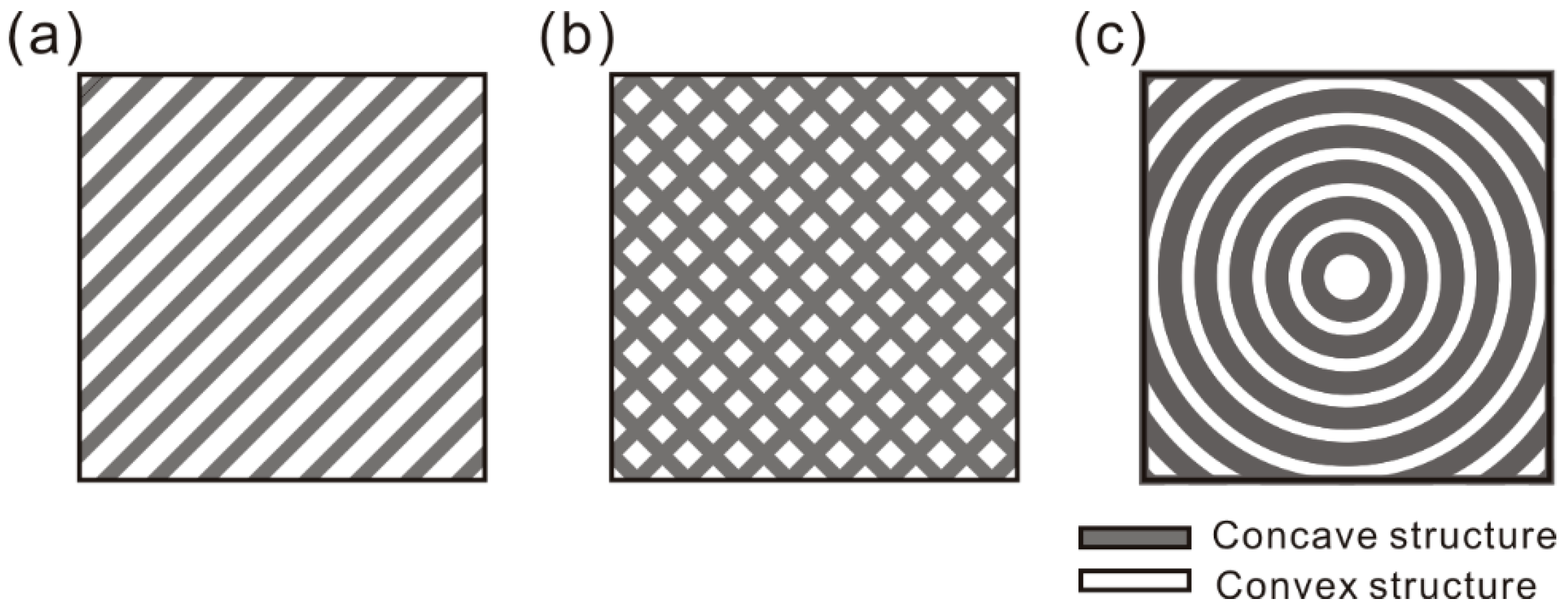
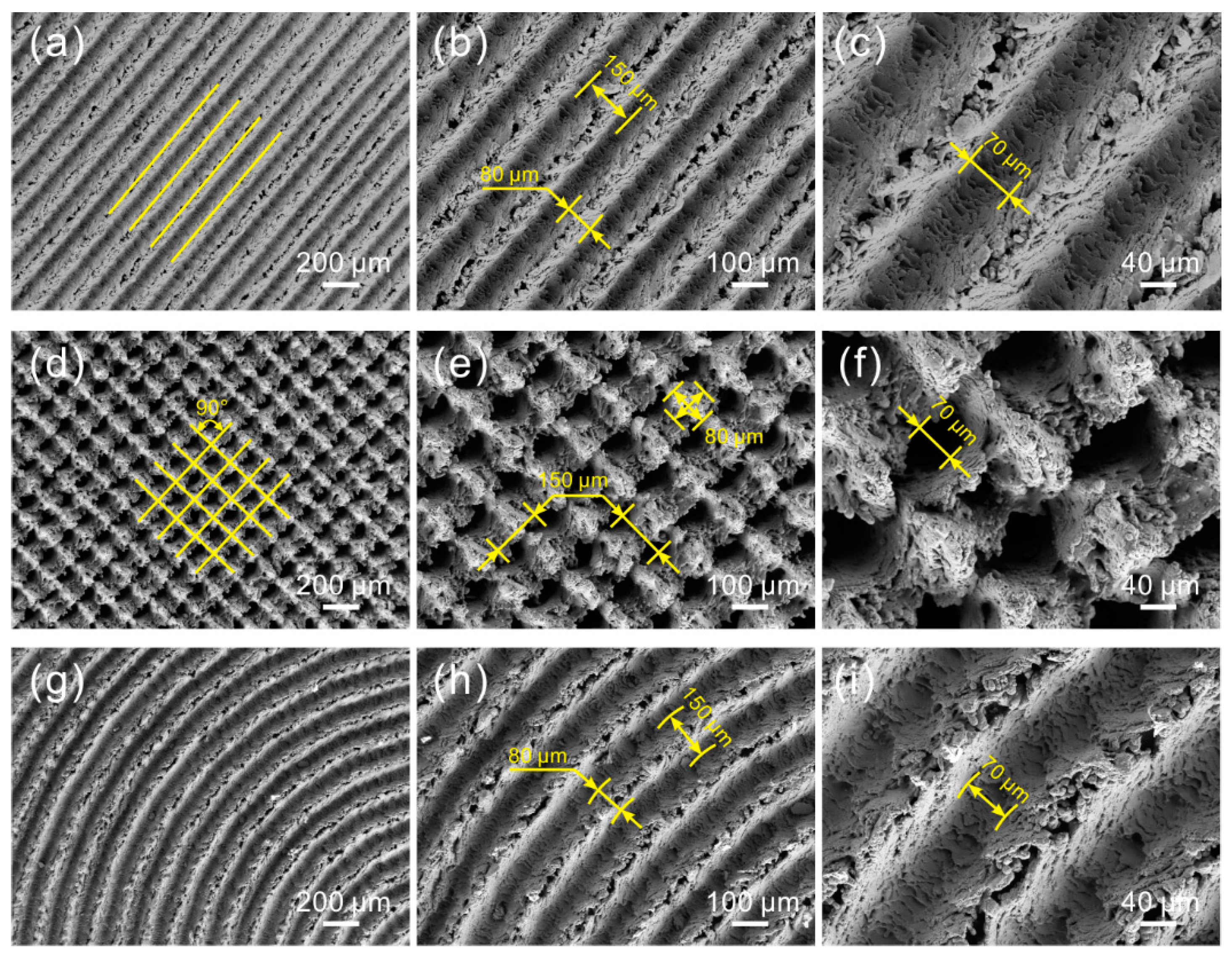
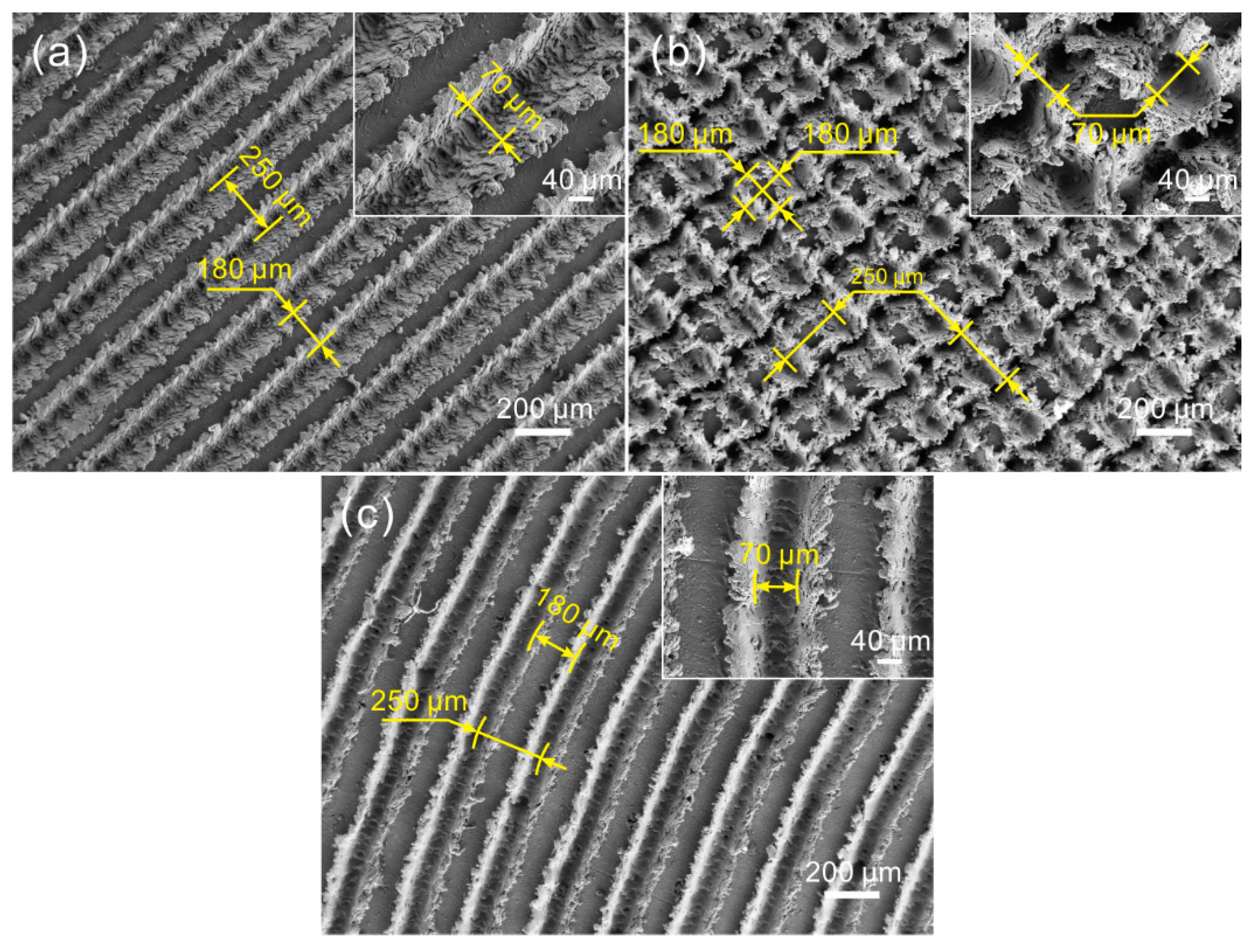
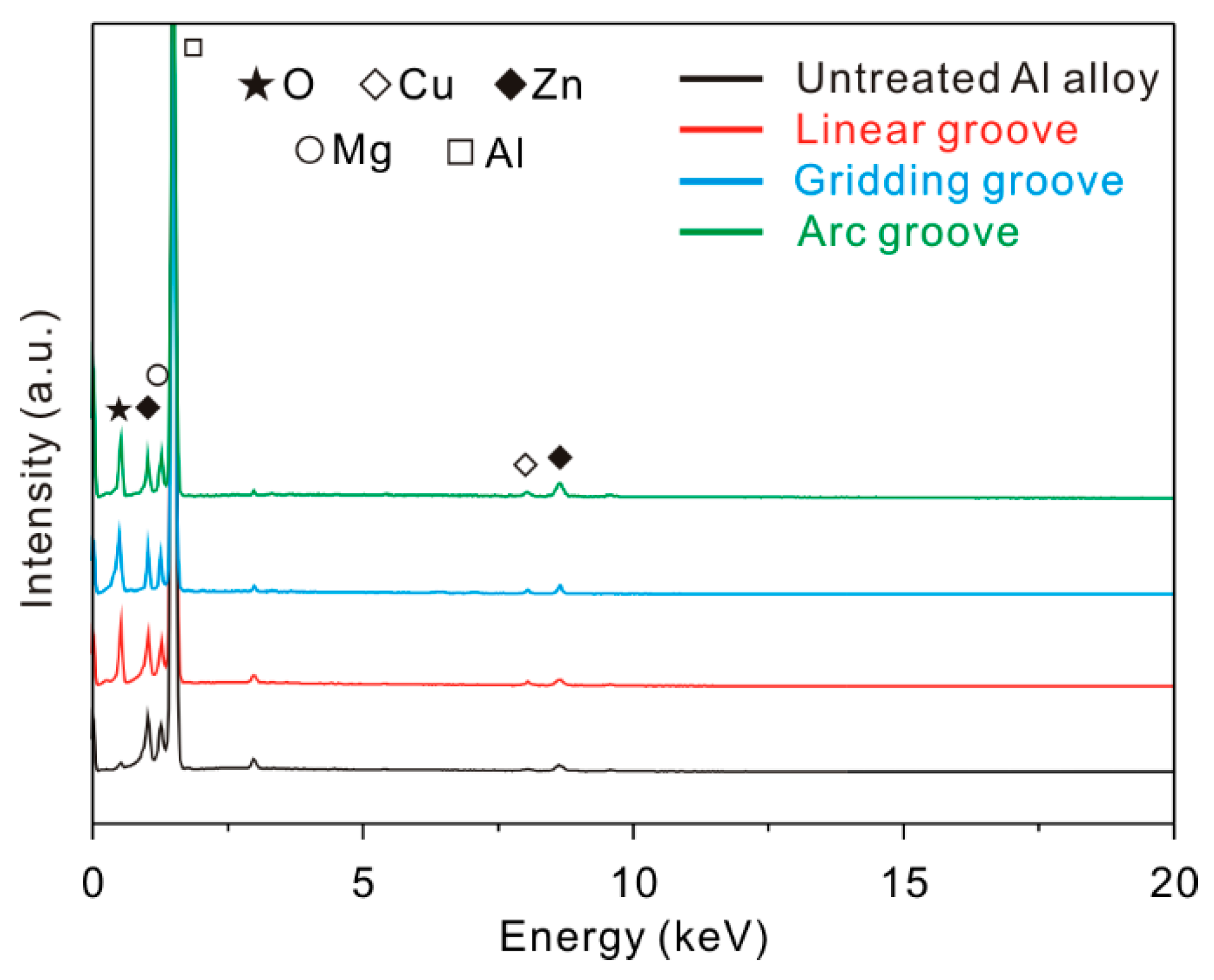
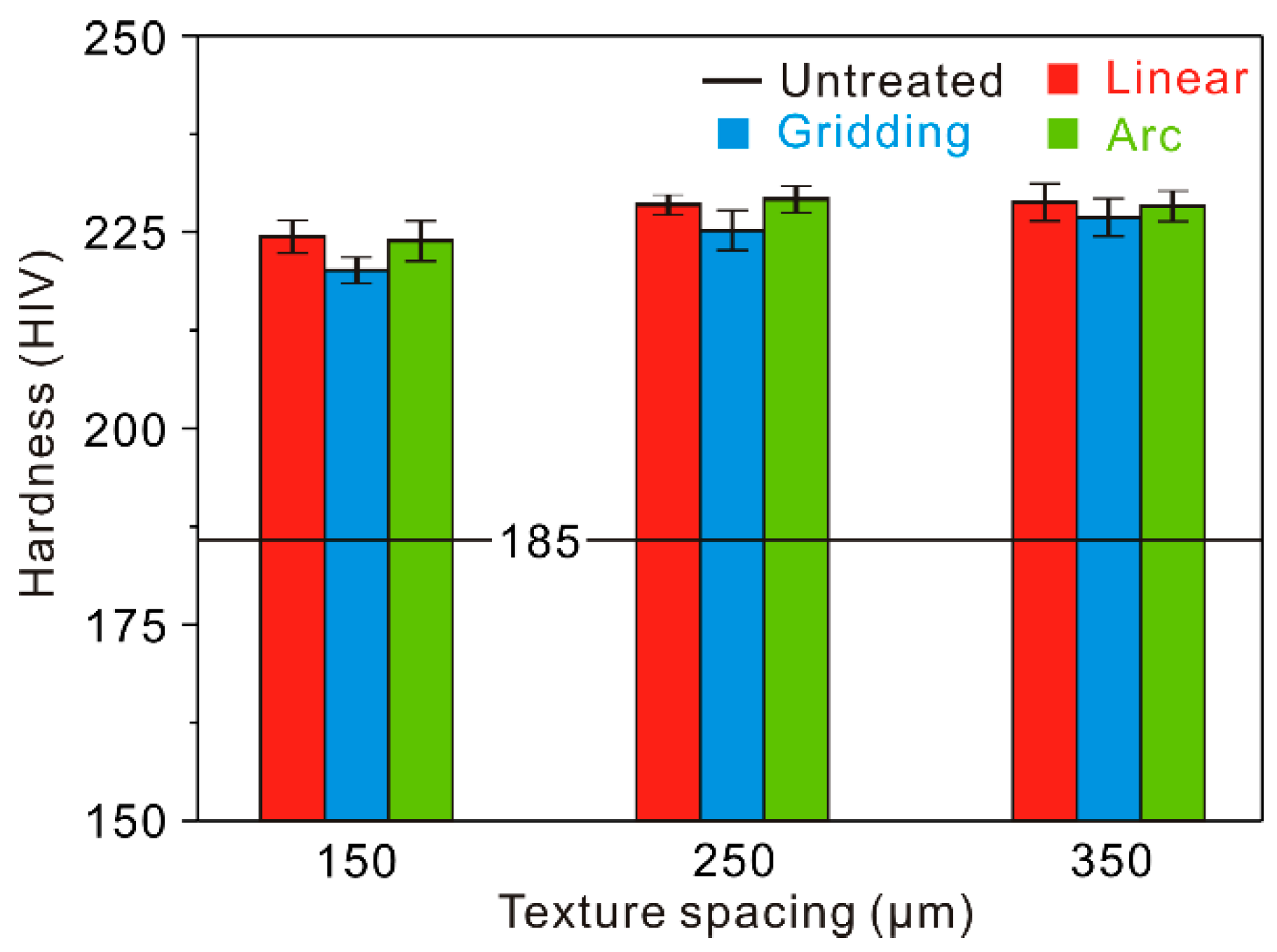
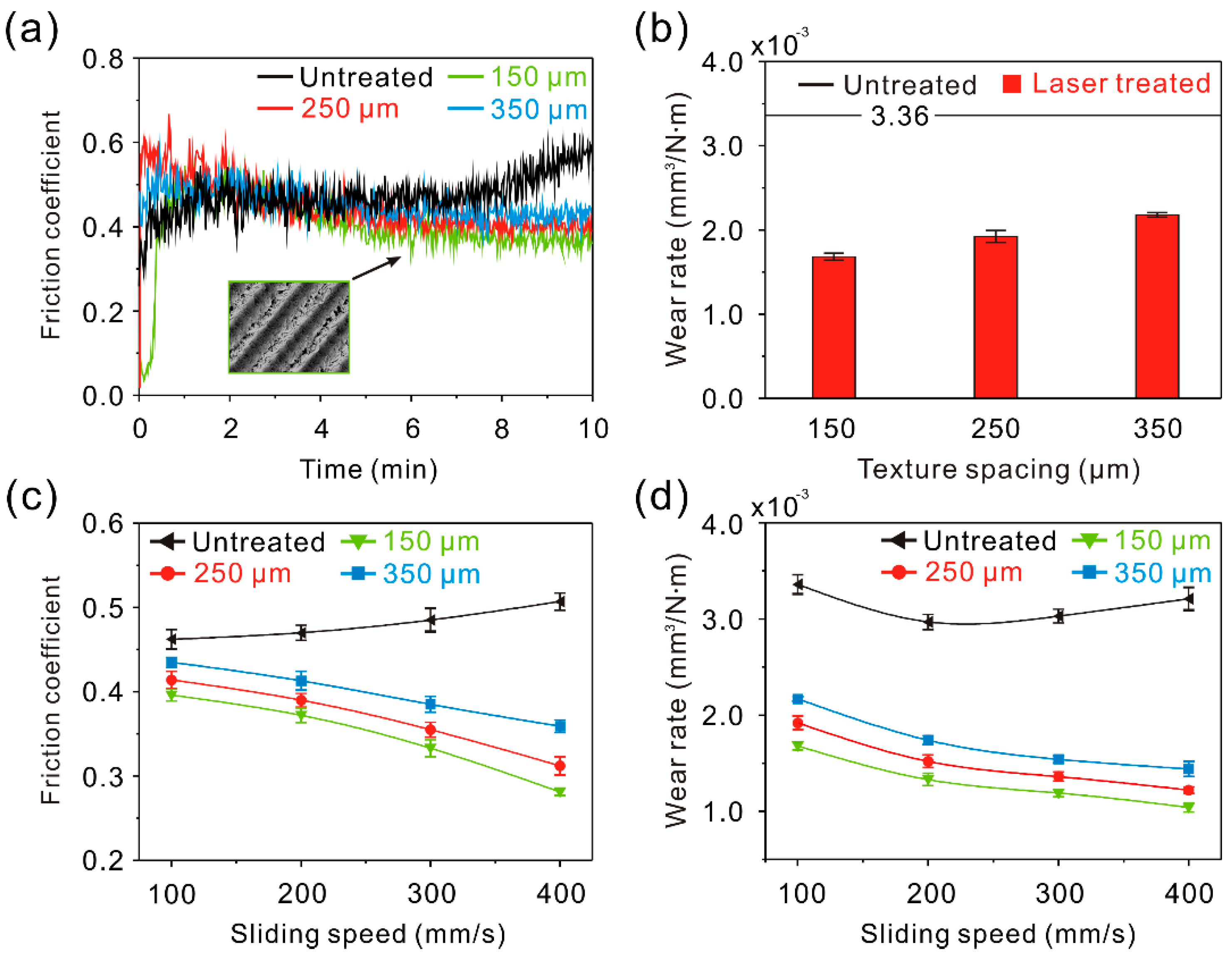


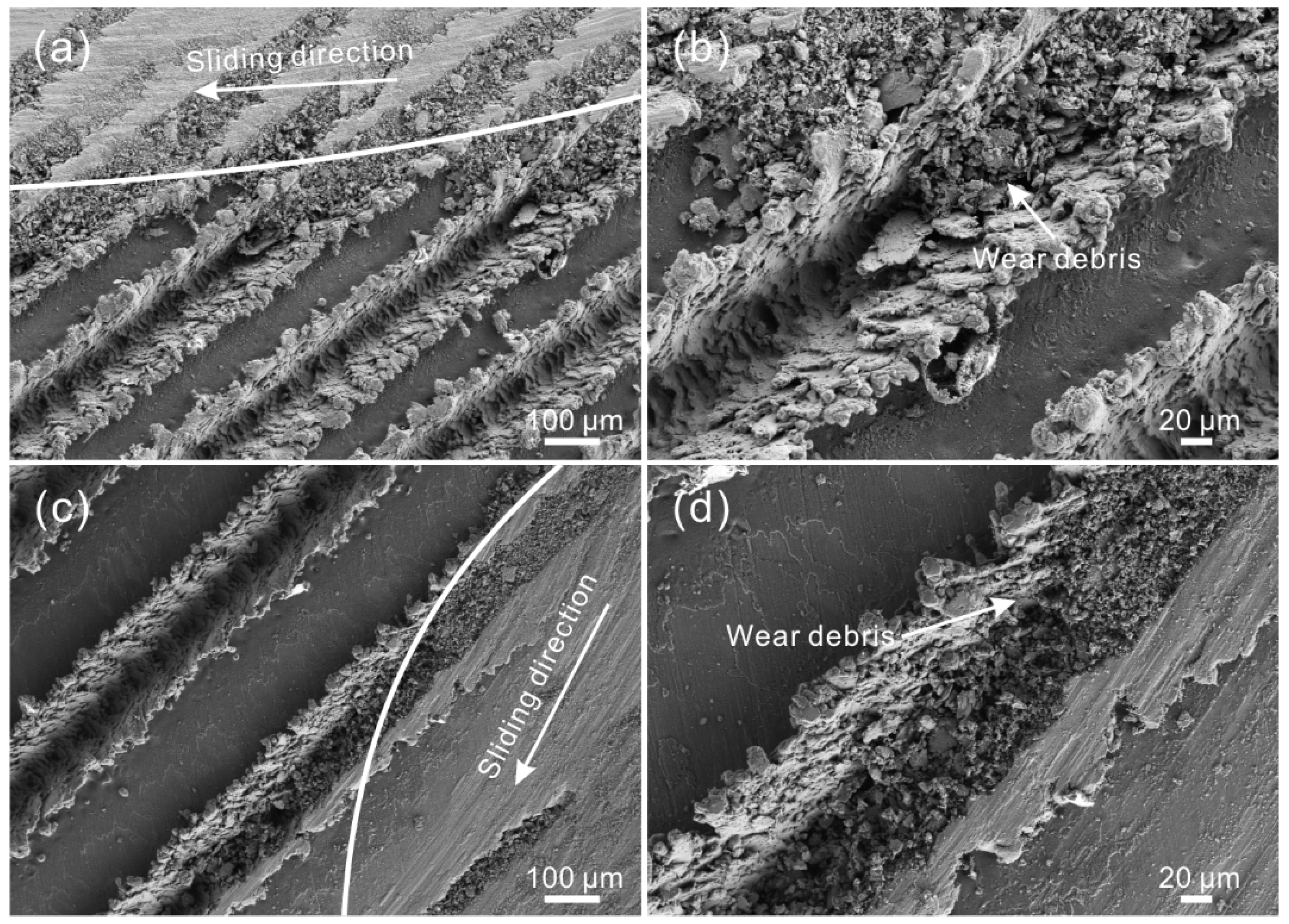
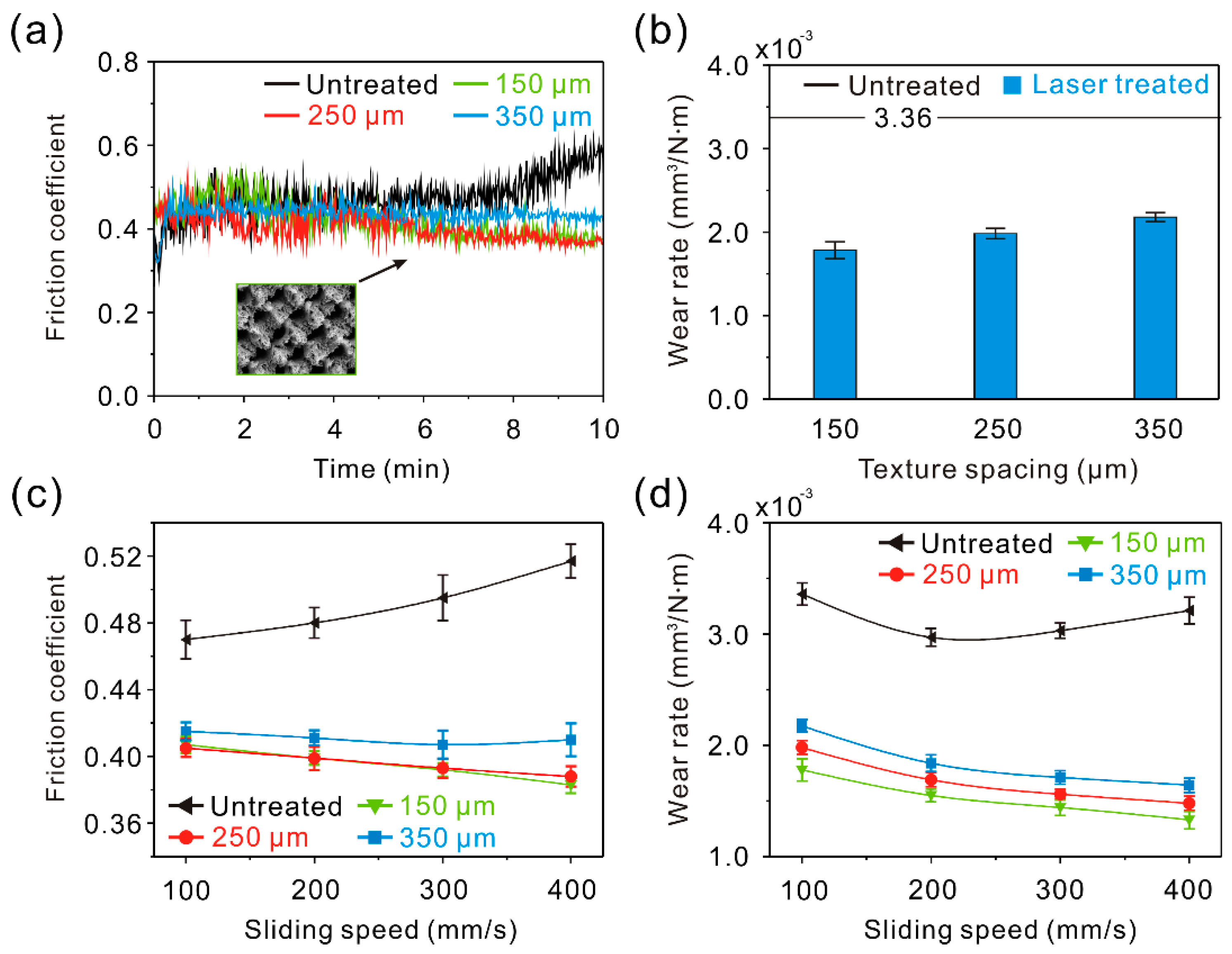
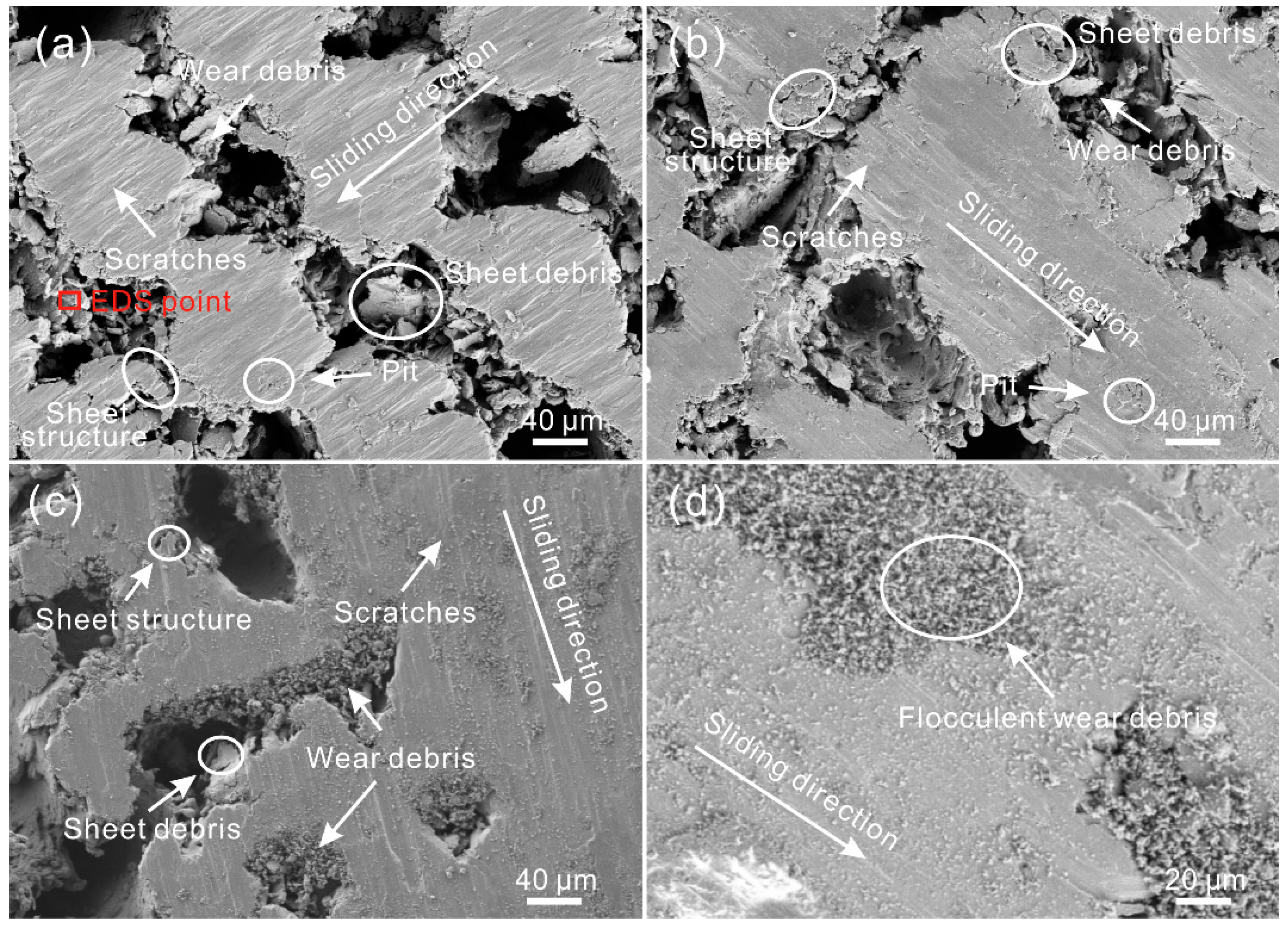
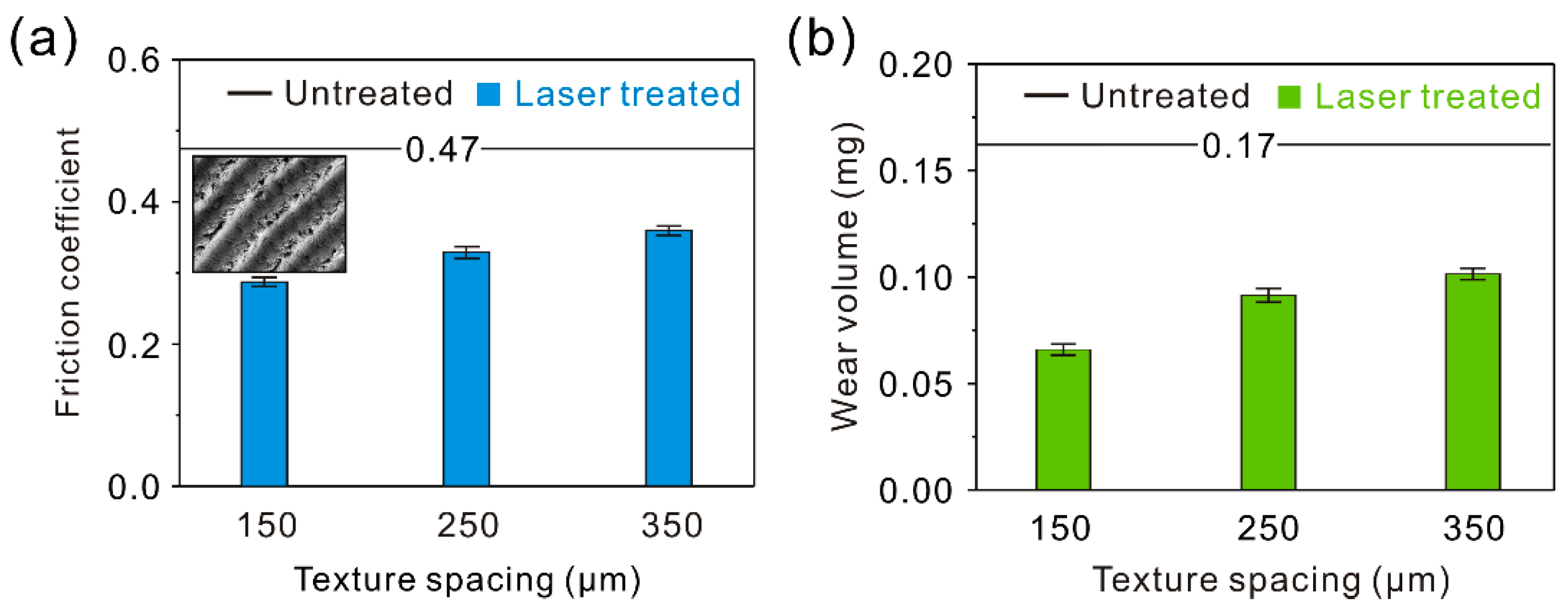
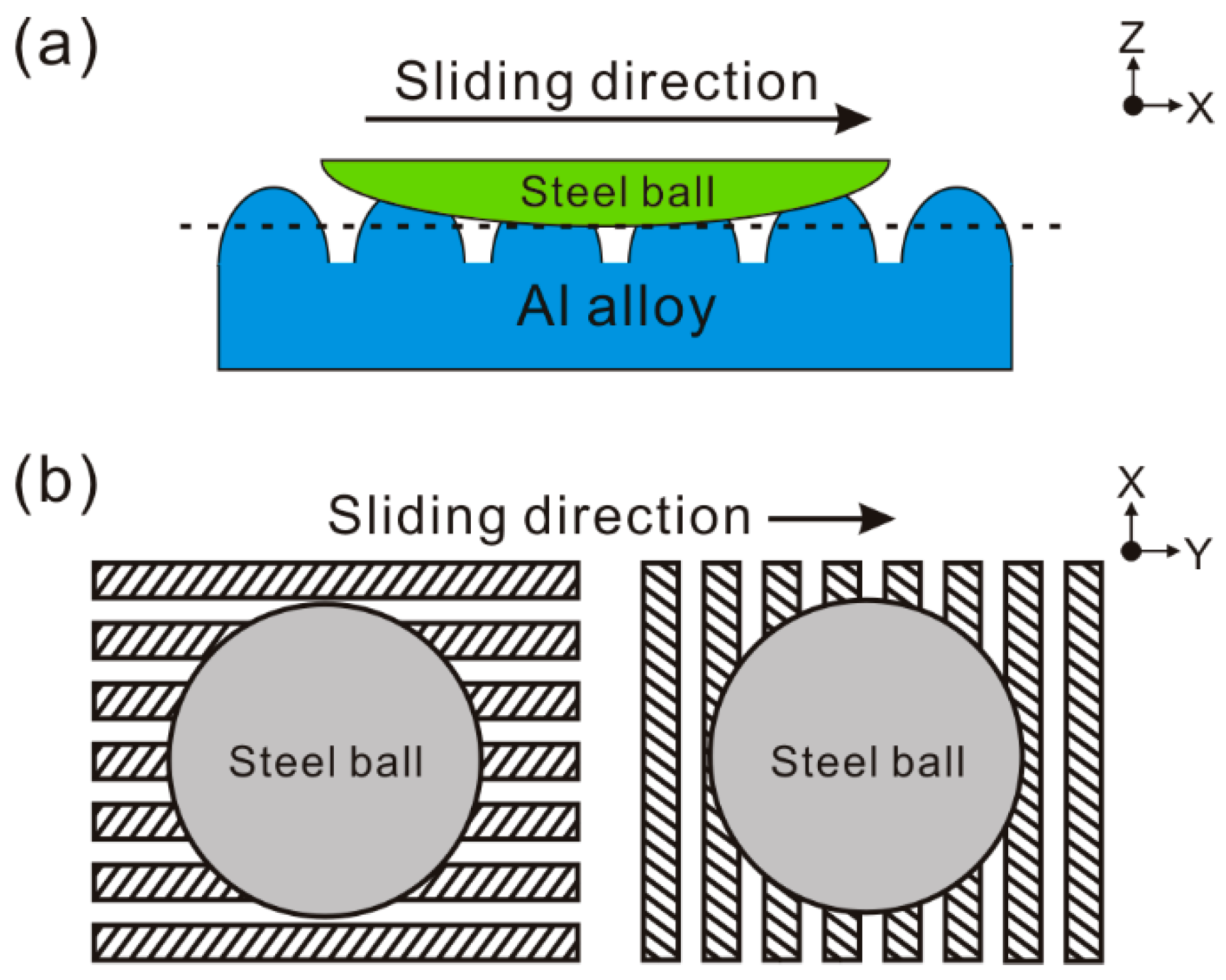
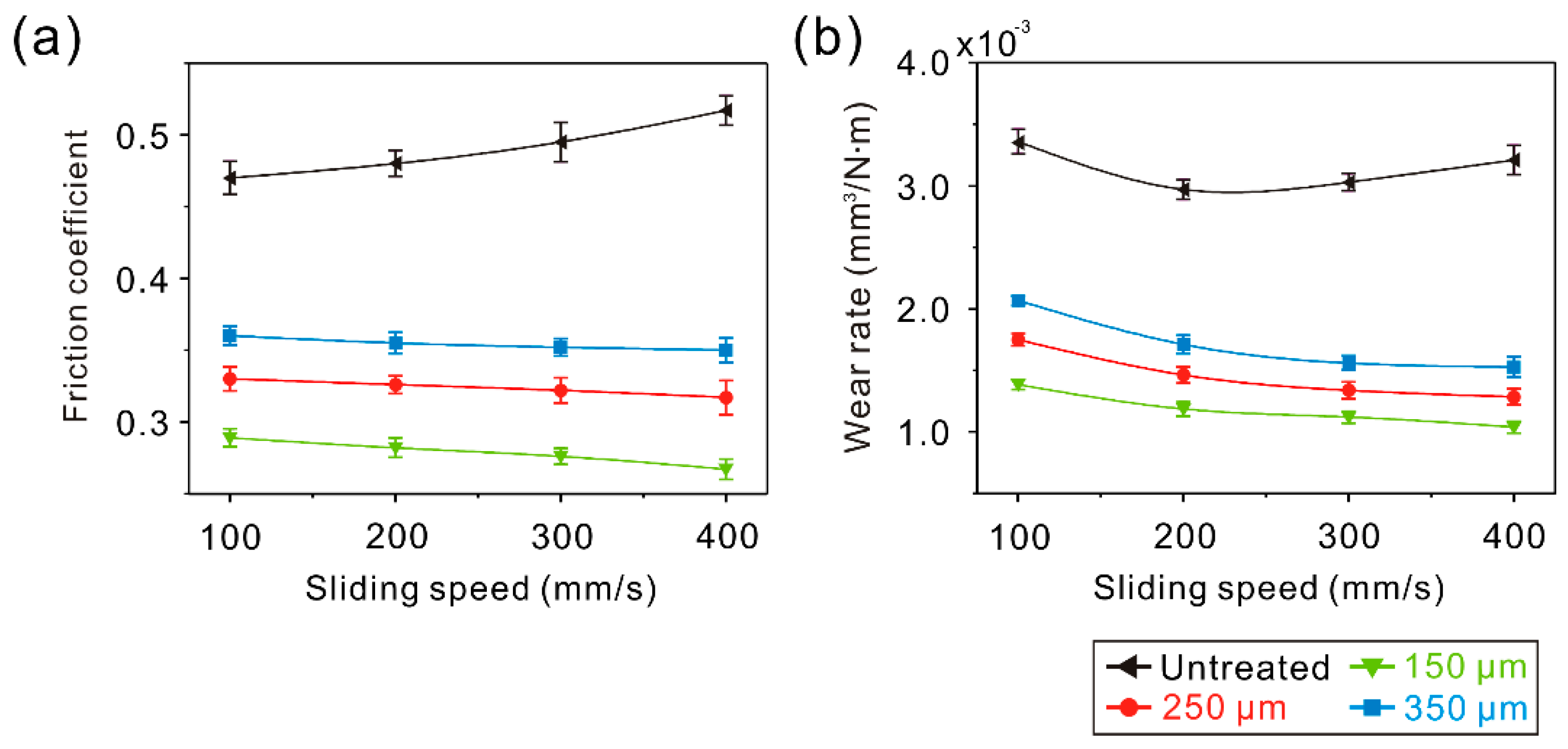

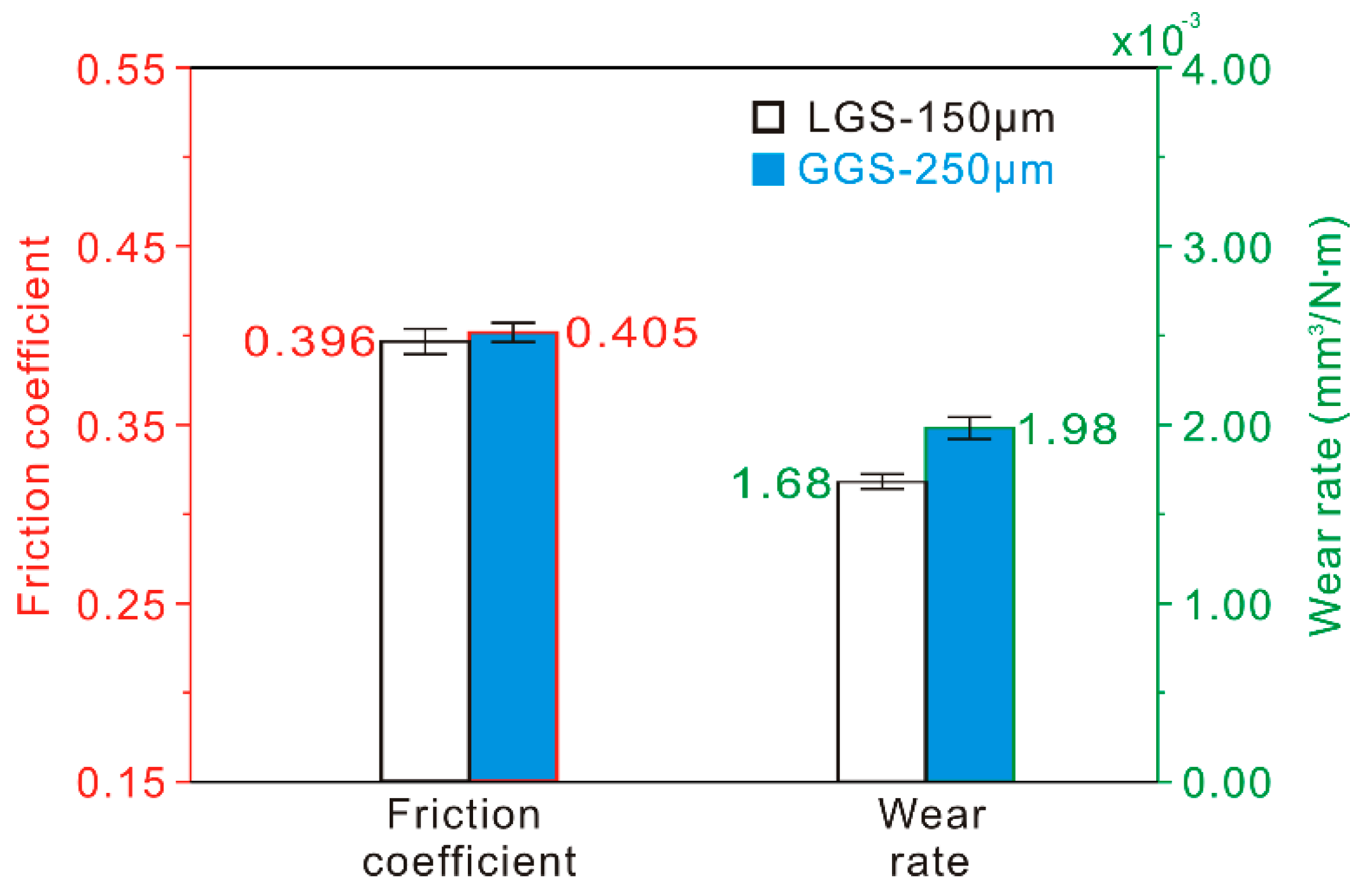
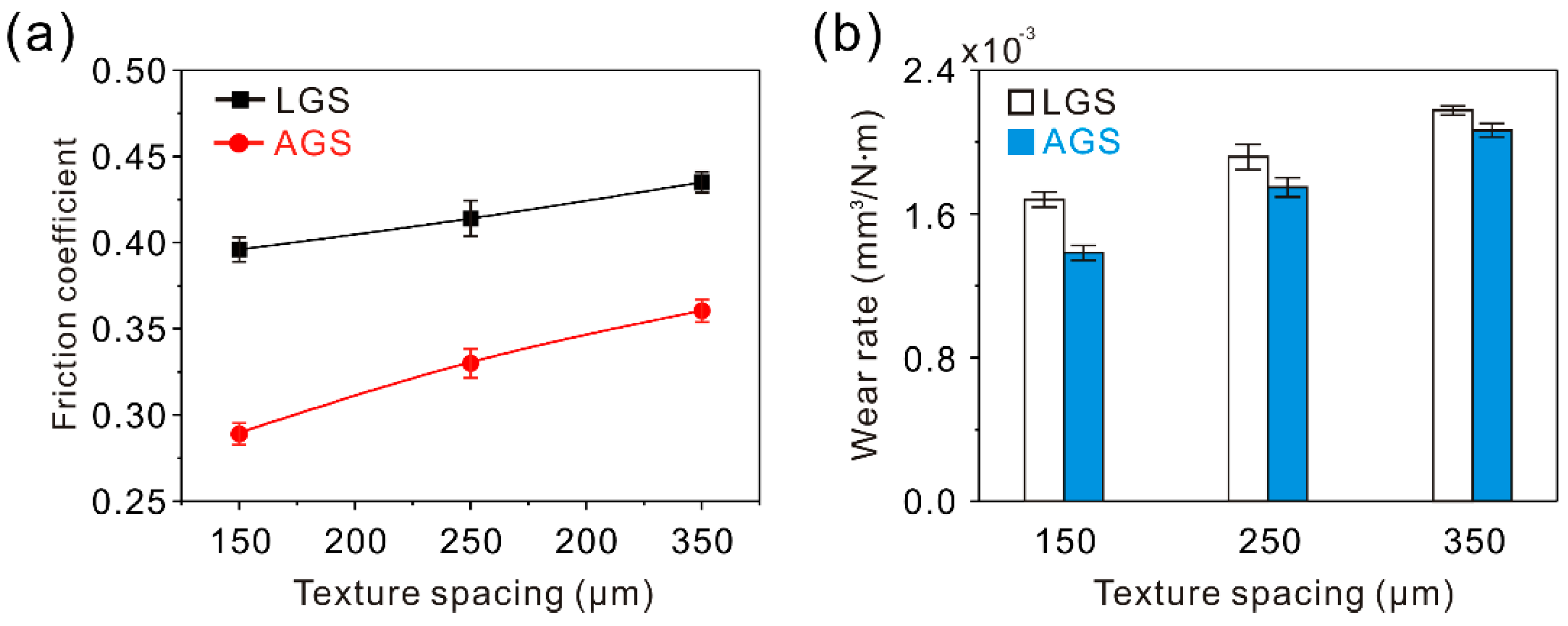
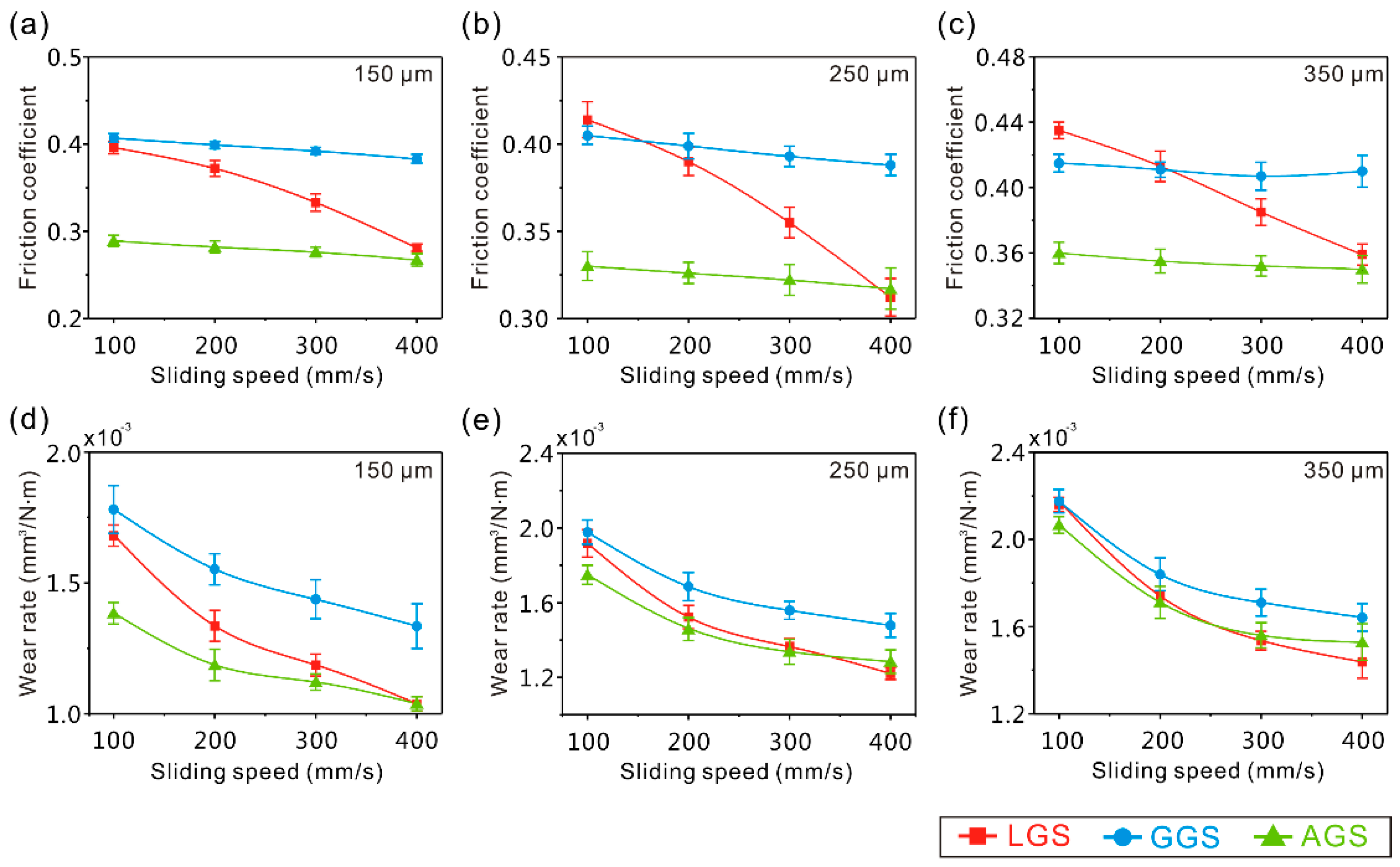
| Morphology | Texture Spacing (μm) | Laser Frequency (Hz) | Scanning Speed (cm/s) | ||
|---|---|---|---|---|---|
| Linear groove | 150 | 250 | 350 | 5000 | 20 |
| Gridding groove | 150 | 250 | 350 | 5000 | 20 |
| Arc groove | 150 | 250 | 350 | 5000 | 20 |
| Linear Groove Surface (LGS) | Spacing of Linear Groove (μm) | Width of Convex Structure (μm) | Width of Concave Structure (μm) | Distribution Density of Convex Structure |
| 150 | 80 | 70 | 53% | |
| 250 | 180 | 70 | 72% | |
| 350 | 280 | 70 | 80% | |
| Gridding Groove Surface (GGS) | Spacing of Gridding Groove (μm) | Size of Square Convex Structure (μm) | Width of Concave Structure (μm) | Distribution Density of Square Convex Structure |
| 150 | 80 × 80 | 70 | 28.4% | |
| 250 | 180 × 180 | 70 | 52% | |
| 350 | 280 × 280 | 70 | 64% | |
| Arc Groove Surface (AGS) | Spacing of Arc Groove (μm) | Width of Convex Structure (μm) | Width of Concave Structure (μm) | Distribution Density of Convex Structure |
| 150 | 70 | 70 | 53% | |
| 250 | 180 | 70 | 72% | |
| 350 | 280 | 70 | 80% |
| Element | Untreated Surface (at %) | Linear Groove Surface (at %) | Gridding Groove Surface (at %) | Arc Groove Surface (at %) |
|---|---|---|---|---|
| O | 1.37 | 11.54 | 11.79 | 11.31 |
| Mg | 2.20 | 3.16 | 3.32 | 3.28 |
| Al | 93.67 | 81.06 | 80.44 | 81.22 |
| Cu | 0.39 | 0.88 | 0.97 | 0.91 |
| Zn | 2.37 | 3.36 | 3.48 | 3.28 |
| Sample | Location | O | Mg | Al | Cu | Zn |
|---|---|---|---|---|---|---|
| LGS | Worn surface (at %) | 7.46 | 2.52 | 86.73 | 0.64 | 2.65 |
| Wear debris (at %) | 10.50 | 2.62 | 83.84 | 0.61 | 2.43 | |
| GGS | Worn surface (at %) | 7.33 | 2.59 | 87.41 | 0.49 | 2.18 |
| Wear debris (at %) | 9.62 | 2.38 | 85.01 | 0.78 | 2.21 | |
| AGS | Worn surface (at %) | 7.95 | 2.76 | 85.97 | 0.74 | 2.58 |
| Wear debris (at %) | 11.02 | 2.59 | 83.45 | 0.61 | 2.33 |
© 2019 by the authors. Licensee MDPI, Basel, Switzerland. This article is an open access article distributed under the terms and conditions of the Creative Commons Attribution (CC BY) license (http://creativecommons.org/licenses/by/4.0/).
Share and Cite
Tang, M.; Zhang, L.; Shi, Y.; Zhu, W.; Zhang, N. Research on the Improvement Effect and Mechanism of Micro-Scale Structures Treated by Laser Micro-Engraving on 7075 Al Alloy Tribological Properties. Materials 2019, 12, 630. https://doi.org/10.3390/ma12040630
Tang M, Zhang L, Shi Y, Zhu W, Zhang N. Research on the Improvement Effect and Mechanism of Micro-Scale Structures Treated by Laser Micro-Engraving on 7075 Al Alloy Tribological Properties. Materials. 2019; 12(4):630. https://doi.org/10.3390/ma12040630
Chicago/Turabian StyleTang, Mingkai, Lichao Zhang, Yusheng Shi, Wenzhi Zhu, and Nan Zhang. 2019. "Research on the Improvement Effect and Mechanism of Micro-Scale Structures Treated by Laser Micro-Engraving on 7075 Al Alloy Tribological Properties" Materials 12, no. 4: 630. https://doi.org/10.3390/ma12040630




